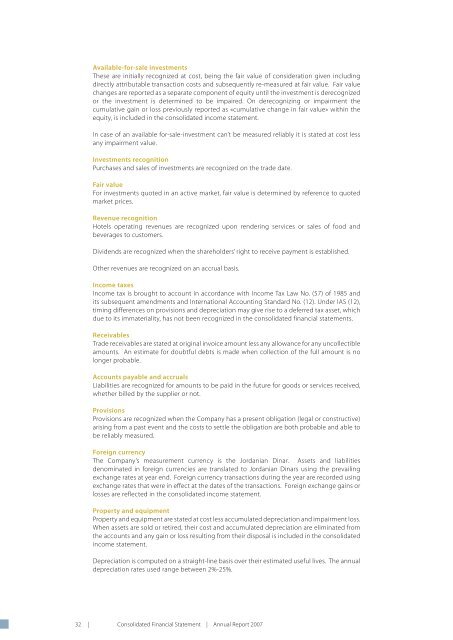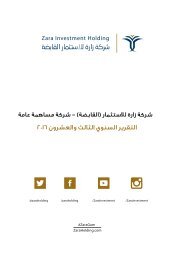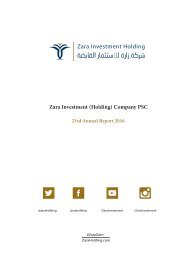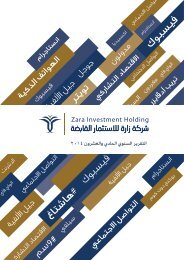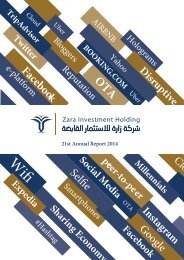ZaraAnnual-English2007
You also want an ePaper? Increase the reach of your titles
YUMPU automatically turns print PDFs into web optimized ePapers that Google loves.
Available-for-sale investments<br />
These are initially recognized at cost, being the fair value of consideration given including<br />
directly attributable transaction costs and subsequently re-measured at fair value. Fair value<br />
changes are reported as a separate component of equity until the investment is derecognized<br />
or the investment is determined to be impaired. On derecognizing or impairment the<br />
cumulative gain or loss previously reported as «cumulative change in fair value» within the<br />
equity, is included in the consolidated income statement.<br />
In case of an available for-sale-investment can’t be measured reliably it is stated at cost less<br />
any impairment value.<br />
Investments recognition<br />
Purchases and sales of investments are recognized on the trade date.<br />
Fair value<br />
For investments quoted in an active market, fair value is determined by reference to quoted<br />
market prices.<br />
Revenue recognition<br />
Hotels operating revenues are recognized upon rendering services or sales of food and<br />
beverages to customers.<br />
Dividends are recognized when the shareholders’ right to receive payment is established.<br />
Other revenues are recognized on an accrual basis.<br />
Income taxes<br />
Income tax is brought to account in accordance with Income Tax Law No. (57) of 1985 and<br />
its subsequent amendments and International Accounting Standard No. (12). Under IAS (12),<br />
timing differences on provisions and depreciation may give rise to a deferred tax asset, which<br />
due to its immateriality, has not been recognized in the consolidated financial statements.<br />
The useful lives and depreciation methods are reviewed periodically to ensure that the<br />
method and period of depreciation are consistent with the expected pattern of economic<br />
benefits from items of property and equipment.<br />
Land<br />
Land lots are stated at cost.<br />
Borrowings<br />
Interest on loans and bonds is recognized as an expense in the period in which it is incurred,<br />
which covers the grace period if any. Interest which is directly attributable to financing of<br />
projects in progress is capitalized as part of the projects’ costs.<br />
Projects in progress<br />
Projects in progress represent properties under construction and are stated at cost. This<br />
includes the cost of construction and other direct costs.<br />
Projects in progress are not depreciated until such time as the relevant assets are completed<br />
and put into operational use.<br />
Contingencies<br />
Contingent liabilities are not recognized in the consolidated financial statements. They are<br />
disclosed unless the possibility of an outflow of resources embodying economic benefits is<br />
remote.<br />
A contingent asset is not recognized in the consolidated financial statements but disclosed<br />
when an inflow of economic benefit is probable.<br />
Subsequent events<br />
Post-year-end events that provide additional information about the Company’s position at<br />
the consolidated balance sheet date (adjusting events), are reflected in the consolidated<br />
financial statements. Post-year-end events that are not adjusting events are disclosed in the<br />
notes when material.<br />
Receivables<br />
Trade receivables are stated at original invoice amount less any allowance for any uncollectible<br />
amounts. An estimate for doubtful debts is made when collection of the full amount is no<br />
longer probable.<br />
Accounts payable and accruals<br />
Liabilities are recognized for amounts to be paid in the future for goods or services received,<br />
whether billed by the supplier or not.<br />
Provisions<br />
Provisions are recognized when the Company has a present obligation (legal or constructive)<br />
arising from a past event and the costs to settle the obligation are both probable and able to<br />
be reliably measured.<br />
Foreign currency<br />
The Company’s measurement currency is the Jordanian Dinar. Assets and liabilities<br />
denominated in foreign currencies are translated to Jordanian Dinars using the prevailing<br />
exchange rates at year end. Foreign currency transactions during the year are recorded using<br />
exchange rates that were in effect at the dates of the transactions. Foreign exchange gains or<br />
losses are reflected in the consolidated income statement.<br />
Property and equipment<br />
Property and equipment are stated at cost less accumulated depreciation and impairment loss.<br />
When assets are sold or retired, their cost and accumulated depreciation are eliminated from<br />
the accounts and any gain or loss resulting from their disposal is included in the consolidated<br />
income statement.<br />
Depreciation is computed on a straight-line basis over their estimated useful lives. The annual<br />
depreciation rates used range between 2%-25%.<br />
32 | Consolidated Financial Statement | Annual Report 2007<br />
| 33


